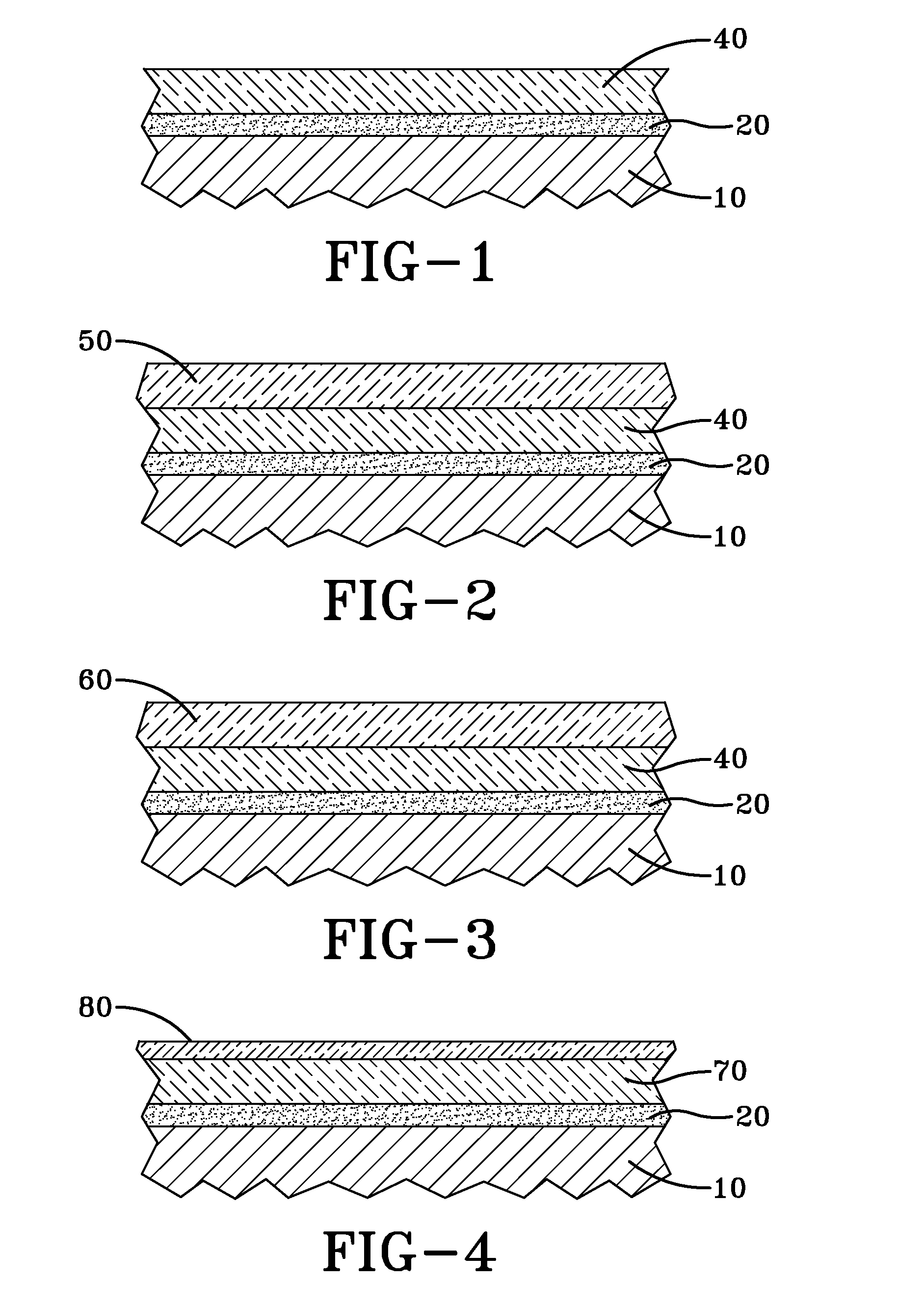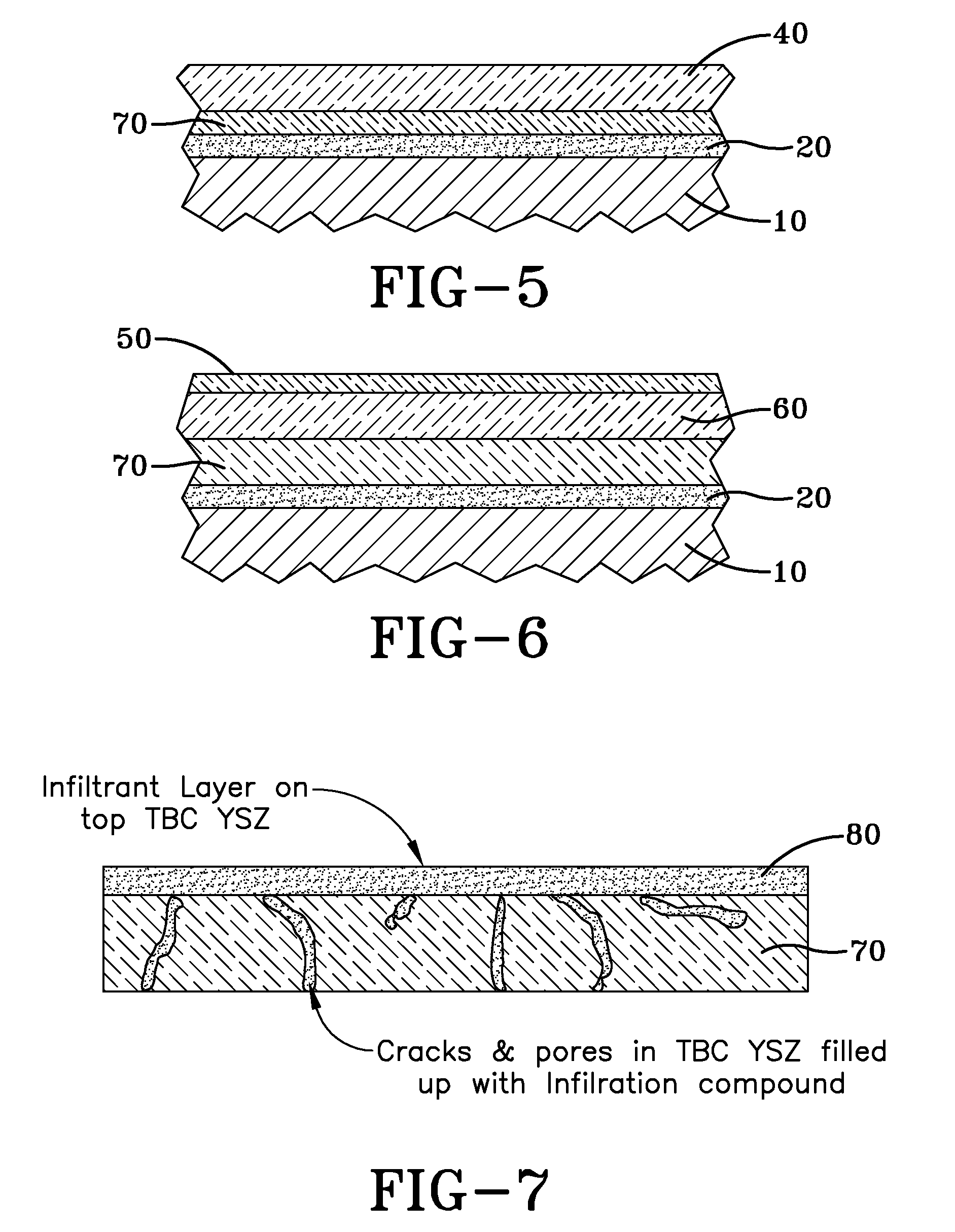Vanadium resistant coating system
a coating system and vanadium technology, applied in the field of coating systems, can solve the problems of shortening the life of the mgo, increasing the maintenance time of the turbine, and not completely preventing the mgo, so as to reduce the overall down time for repairs and increase the average length of time between shutdowns
- Summary
- Abstract
- Description
- Claims
- Application Information
AI Technical Summary
Benefits of technology
Problems solved by technology
Method used
Image
Examples
first embodiment
[0023]FIG. 1 represents the coating system. In this embodiment, as in all embodiments described herein, the coating system includes a substrate 10. While the substrate may be any metallic material capable of operating at high temperatures at or in excess of about 2000° F. (1093° C.), these high temperature metallic materials usually are superalloys, including but not limited to Ni-based superalloys, Co-based superalloys, Fe-based superalloys and superalloys that include combinations of Ni, Fe and Co. These superalloys are capable of operating at extended periods of time at temperatures at or in excess of 2000° F. (1093° C.) when appropriate steps are taken to protect the superalloy substrates from corrosion and / or oxidation.
[0024]In this first embodiment, immediately overlying substrate 10 is a bond coat 20. Bond coat 20 may be a MCrAlY applied over the metallic substrate, where M is a metal selected from the group consisting of Ni, Co, Fe and combinations thereof, although other bo...
second embodiment
[0027]the coating system is set forth in FIG. 2. This second coating system differs from the coating system set forth in FIG. 1 in that it includes an additional ceramic top coat 50 overlying ceramic coating 40. Substrate 10, bond coat 20, and ceramic coating 40 are substantially identical to these features as described in the embodiment set forth in FIG. 1. Additional ceramic top coat 50 overlies ceramic coating 40 but differs from the ceramic coating in that it further comprises a YSZ layer stabilized by 2-20 weight percent yttria. Such a YSZ layer includes porosity and cracks, typically in the form of microcracks, as are usually found in ceramic coatings applied by well-known thermal spray processes. However this YSZ coating differs from well-known YSZ layers in that the layer further includes zirconia stabilized by about 5-10 weight percent of a rare earth species having a larger atomic radius that Y3+. These rare earth species include a cation selected from the group consisting...
third embodiment
[0030]the coating system is set forth in FIG. 3. This third coating system differs from the coating system set forth in FIG. 2 in that it includes second ceramic coating 60 overlying first ceramic coating 40. Second ceramic layer 60 desirably is a pyrochlore composition or cerium stabilized zirconia (CSZ). Pyrochlores have a general formula of A2B2O7, where A is a metal having a valence of 2+ or 3+, for example, gadolinium, aluminum, cerium, lanthanum or yttrium, and B is a metal having a valence of 4+ or 5+, for example, hafnium, titanium, cerium or zirconium, where the sum of the valences of the A and B metals is 7. However, ceramic coating 40 is then relied on to provide further protection for the system, and the sacrificial nature of second ceramic layer 60 will have served its purpose in delaying first ceramic layer 40 from full exposure to the vanadium species.
[0031]Spalling could occur due to a number of mechanisms, including corrosive attack of the ceramic overcoats 40, 50, ...
PUM
| Property | Measurement | Unit |
|---|---|---|
| temperatures | aaaaa | aaaaa |
| temperature | aaaaa | aaaaa |
| thickness | aaaaa | aaaaa |
Abstract
Description
Claims
Application Information
 Login to View More
Login to View More - R&D
- Intellectual Property
- Life Sciences
- Materials
- Tech Scout
- Unparalleled Data Quality
- Higher Quality Content
- 60% Fewer Hallucinations
Browse by: Latest US Patents, China's latest patents, Technical Efficacy Thesaurus, Application Domain, Technology Topic, Popular Technical Reports.
© 2025 PatSnap. All rights reserved.Legal|Privacy policy|Modern Slavery Act Transparency Statement|Sitemap|About US| Contact US: help@patsnap.com



